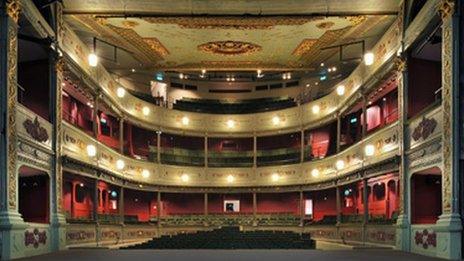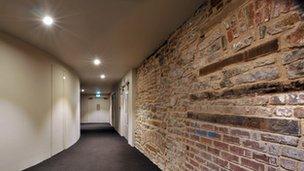Bristol Old Vic revamp uncovers secrets
- Published

The theatre originally had a 'thrust' stage which has now been recreated
Stripping back Britain's oldest continually working playhouse has revealed some hidden secrets as well as ending guesswork about its history.
The first phase of the Bristol Old Vic refurbishment is being completed, 11 years after plans for it were first put in place.
The project, which has so far cost £12m, began in earnest in 2009 when Tom Morris took over as artistic director and Emma Stenning became executive director.
Their aim was to celebrate the unique shape of the 18th Century theatre while bringing other aspects into the 21st Century - it finally has the new seats first promised in 1962.
There were no original designs to work from, so a team of historians was appointed to advise and discover the peculiarities of the building.
Cannon balls
One of the greatest discoveries was that the theatre originally had a "thrust" stage - a stage which protrudes into the middle of the audience - the front of which was "hacked off" in 1881.
This has now been recreated.
They have also opened up a previously hidden proscenium entrance to the side of where the stage had been.
"It wasn't used from 1880 - until March. It's a really thrilling space," Mr Morris said.
"It's still got prop hooks in it and is impregnated with 18th Century grease paint from actors leaning against it waiting to go on stage.
"There's also some graffiti from 1863 by a man called EJ Harwell, a ship's carpenter and theatre carpenter.
"Under his name there's a beautiful sketch of a schooner in sail, done with a nail presumably while bored."
During the works, a gutter was revealed in the attic along which cannon balls would have been rolled to create the sound of thunder in the days before electronic sound effects.
Other finds include a blocked door leading from the box above the stage to the back-of-house areas.
Archaeologist Cai Mason said: "This door is likely to have been used to provide aristocratic patrons of the theatre with what was known as 'freedom of the scenes'.
"This allowed rich men to meet the performers, or more specifically the actresses, in private."
There are three tiers of seating in the auditorium which now has seats for 540 and standing room for 40.
Mr Morris said the pit, more commonly known as the stalls, had sat 2ft 6ins (75cm) lower when the theatre was built.
'Breathless with excitement'
"Even though there were benches in the pit, in order to see the audience would have had to stand up," he said.
"From the early 19th Century there were frequently promenade concerts. All benches in the pit were removed so they could ram the place with people standing."

There are places where the original beams and stone work have been allowed to show through
He said the front few rows could also now be moved under the stage to leave standing space and "allow us to recover some of the atmosphere of the original design".
He described the restructuring as "like finding a broken Stradivarius cello and building a new semi-electric instrument without spoiling the design".
Theatre historian John Earl said: "I expected to see a few fragments that, with luck, might offer a footnote or two on the history of the place.
"What I actually saw left me breathless with excitement.
"The dig has uncovered an astonishing amount of 18th Century fabric and has shone a brilliant light on the original 1766 theatre, revealing facts previously unknown or only guessed at."
It will not be known if the foundation stone, laid in 1764, has been discovered until phase two of the renovations is under way - at the front of the building.
'Hushed breath moment'
"We've found what we think is the foundation stone but don't know yet because we can't see the other side of it. There may be writing on the other side," Mr Morris said.
Funds are already being raised to renew the front and plans are expected to be announced towards the end of the year.
"We plan to deliver both halves of the theatre in time for our 250th anniversary in 2016," he added.
Mr Morris said the theory that there is an audience for the theatre in Bristol had been borne out by continued attendance at a programme of events during renovations.
"Even during the refurbishment we put Treasure Island on in a street play to over 23,000 people - we think the biggest audience for any Old Vic show since 2000," he said.
The theatre is due to reopen on 5 September with a production of Wild Oats, a comedy by John O'Keeffe.
"It's a hushed breath moment for us being able to get our hands on the stage and make shows, Mr Morris said.
"The thrilling bit is what happens next."
- Published13 May 2011
- Published16 February 2011